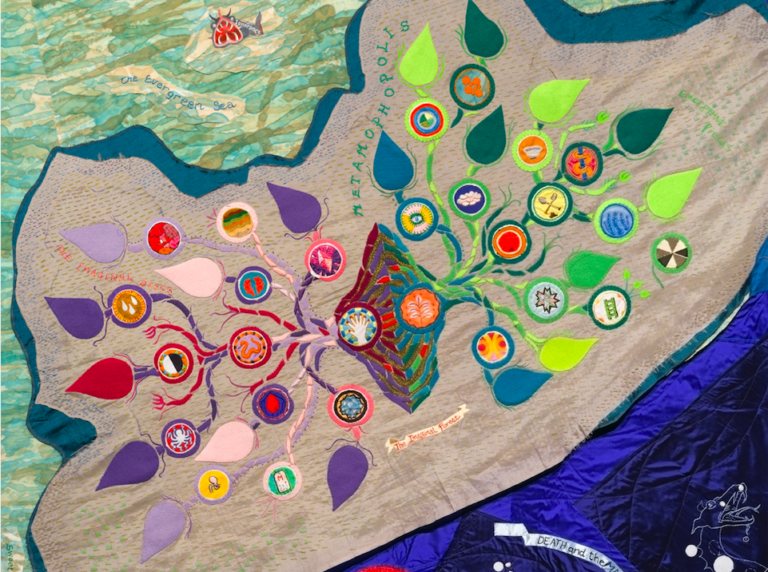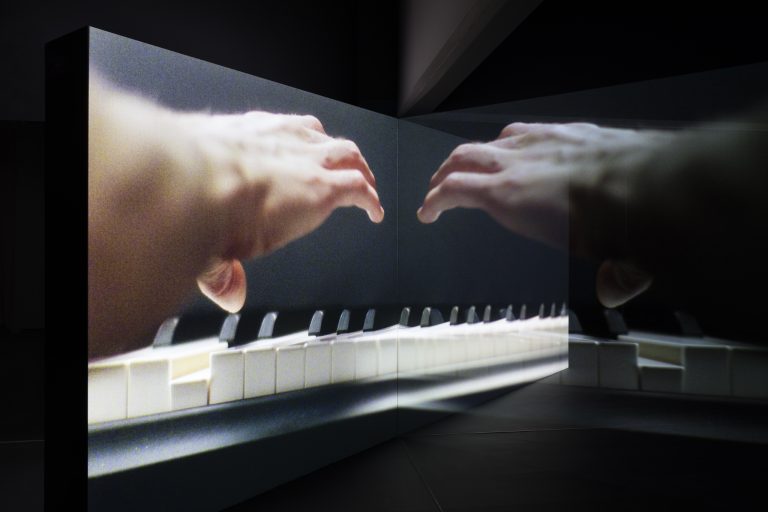I carry it carefully, the dress I will marry in.
I fold it over my elbow, tucked close to my chest, lift my umbrella, and turn towards the city. Over murky puddles and cobbles I heft it, through laneways and broad streets, weaving through bus queues on Patrick Street, around pushchairs and bikes, through a doorway and over the threshold until I am standing at Singer’s Corner, ready to lift my wedding dress into the arms of another woman. Seamstress. There always was and always will be a seamstress for such ordinary moments as this, always with a mouth full of pins and sideways small talk. Every day, her hands work here, as fabric turns, needles are threaded, curtains are lined, and dresses are slipped onto hangers. I am early. I take my place in the line.
The bell over the door rings and rings, and one by one they hurry in; the first bride-to-be, grown loved and plump, needs her seams let out. The next has sculpted herself whippet-thin, and needs her gown taken in and in and in until the satin skims her newly visible rib, and finally she grins. Beyond the broad window where raindrops roll, puddles are dreaming themselves deeper into pavements, soaking the feet of strangers huddled and hurrying under hoods and brollies. My gaze swivels between the English Market and the cathedral on Washington Street, while pedestrian lights turn green, turn red, turn green again, and each time the road fills with the sound of traffic. Inside the shop, the atmosphere is tranquil. Here, the work hums steadily, as it has for years. If an archaeology of sound could be excavated, the strata of this place might include the whir of fabric, the sigh of scissor blades, the babble of seamstresses, the touch of tongue to thread, the low chatter of weather outside, and the low chatter about weather inside.
In a city of tiny laneways and steep hills, corners were seldom deemed worthy of being named, but Singer’s Corner is a landmark, a meeting point, an island. Some might assume (as I once did) that the name relates to some folklore of song, but in fact it gained its name from the corporation – the Singer Sewing Machine Company – which has traded in this building in the middle of Cork city since 1875. Since the second half of the nineteenth century, six days a week, these rooms have filled with people, with seamstresses working and customers standing, one by one at the counter, articulating their needs. Online, I once happened upon a quote attributed to Louise Bourgeois: “The act of sewing is a process of emotional repair.” So many human stories and emotions have gathered in the folds of heaped fabrics here.
Five years after I walked down the aisle in my wedding dress – stitched and trimmed to perfection at Singer’s Corner – Cork City Council proposed a scheme to commission new public art. Following the usual bureaucratic requirements of meetings, agendas, minutes, draft documents, paperwork, signatures, and final final approvals, the council advertised its new scheme. It drew on the Department of Environment, Community, and Local Government’s Public Area Enhancement Scheme, providing a fund to create a public art installation for a number of historic buildings. Johnny Bugler’s pitch for Singer’s Corner – drawn from both the heritage and function of the building – was selected.
Bugler, a member of Cork Printmakers, proposed an ambitious design to be painted onto the building’s three-storey exterior. His design responded not only to the fabric of the historic building but also to the surrounding cityscape. The River Lee once flowed here until merchants ordered it to be redirected into culverts. And a broad street was subsequently built where the river once glugged and churned. It was called Sráid an Chapaill Bhuí (Yellow Horse Road) after a much older piece of public art, a commissioned statue of King George II by Dutch sculptor John van Nost, painted yellow in the early 1780s. The street was later given the more glamorous name Grand Parade. In a certain light, the bright curlicues Bugler planned for Singer’s Corner arc and wink the way a sunset reflects on wavelets, always in momentum, echoing the human movement jostling through the streets below.
With a team of fellow artists (Fiona Kelly, Dominic Fee, Conall Cary, and Cathal Duane), Bugler began work on the façade in 2014. The project required the construction of a four-storey-high scaffold on one of the busiest pedestrian junctions in the city. The artists hand-painted Bugler’s vast design, covering the upper three floors of the building in an undercoat of deep velvet black, which was then embellished in a convoluted pattern of yellow vines and blossoms.
The tone of the yellow chosen is garish, brazen, gaudy. It calls to mind the nightclub signs further down Washington Street: neon lights illuminating wet pavements at night. The pattern depicted, however, is delicate, branching, and immediately recognisable to anyone with a fondness for the golden motifs of the Singer sewing machine.
A glimpse of that motif in an antique shop display is sufficient to make me pause, and dawdle a moment. The sight of it alone evokes such a depth of imagined sound: the steady pulse of its stitching heart thud thud thud, the spool unspooling, the dance of heel and toe on treadle. I’m not alone in my affection for these machines. A Singer sewing machine is a thing of beauty, encased in its ebony shell, glossy as a cockroach, tattooed in its gilded curlicues. There is a poetry to the mechanical components of these machines that demands recitation. Paper Visual Art Journal is not a poetry journal – it is stated on their online submissions page that they ‘do not publish poetry’ – but on this occasion I am going to propose an exception:
~ winder spool ~
~ presser foot ~
~ slide plate ~
~ bobbin case ~
If there is poetry to be discerned in this litany of its parts, there is a poetry in its whole too. The more I dwell on its myriad components, the more the machine assumes a poetic sheen that articulates an echo of feminine domesticity and drudgery, for what is a woman within the home if not a ‘spool holder’, a mistress of ‘top-thread tension’?
The machine could be envisioned as a marionette controlled by the bodies of women. There is an echo here of how often a woman’s domestic responsibilities involve tending the body of another to service the good of all: the infant, the feverish teenager, the elderly, the animal, the many mechanical bodies that command our daily attention. I feel these ever-changing, ever-looping patterns of duty in Bugler’s mural too. The choice of spiralling, twisting vines clearly echoes the Singer’s gold motifs; at the same time, they are an echo of the conventionally feminine.
It is a bold move to take a symbol of domesticity and magnify it in the capitalist heart of a city. Some time after the piece was installed, it was covered by an obnoxious, wraparound advertisement for eir broadband. After a public outcry (enacted largely on social media and radio talk shows), the ad was removed. The controversy made clear the affection the work has earned among the people of Cork, but it also demonstrated how much of the city is reserved for exercises in capitalism, rather than art. The mural seemed to me even brighter when the advertising was lifted; in its reappearance, it became even more significant. It shone.
If this artwork were dark soil on a moonless night, it would be blossoming before our eyes, climbing and clambering over old walls with the tenacity of urban convolvulus. If this building were to be imagined as a body of its own, a body engaged in the industry of clothing others, then Bugler’s piece allows it to clothe itself, resplendent in embroidered velvet. One might imagine it another way – if the building is a body, the work displays its vascular system externally, an intricate map of veins and arteries of vivid yellow blood. The inside out, the outside in – either way, Bugler’s yellow insists itself upon people as they pass by. It draws the gaze, it provokes questions, it summons a multiplicity of metaphoric impressions. Perhaps more than anything, it invites curiosity.
The sign in the window of Singer’s Corner reads ALTERATIONS, and alterations are indeed to come. A number of years ago, the council earmarked a fund of ten thousand euro from the City Centre Action Plan to repaint the building. Rather than maintaining or recoating Bugler’s mural, the council intends to paint over it. It was originally to remain for only one year, but because of the public’s fondness for it, it has been granted repeated reprieves. When this essay was originally written, it was scheduled to remain in place until July 2018. It is still there now, months later, untouched. When I think of it clothed in a new skin of paint, I imagine Man Ray’s L’Enigme d’Isidore Ducasse, a sculptural work first produced in 1920 – a sewing machine bound tightly in fabric and twine that comes the knowledge that no matter how forcefully its covering is tied, the machine still exists within. If not this year, then eventually, I presume, Bugler’s artwork on Singer’s Corner will be assimilated into the many layers still underlying it. Perhaps there is a certain poetry to this too.
The act of sewing involves the binding of one section of fabric to another, creating something functional, something of beauty. Inside Singer’s Corner, this action is enacted time and time and time again, the same looping thread, the same stitches, the same flash of needles, the same tapping treadles. Here, women have worked over garments, turning cloth to clothes, lifting lengths of tweed, silk, and cotton, folding, unfolding, folding again.
Here, it is 1880. The needle’s steel eye fills with thread.
Here, it is 1907. A seamstress’s weary elbow rests on the treadle table.
Here, it is 1919. Someone touches yellow thread to the tip of her tongue.
Here, it is 1931. A whispered curse. A drop of blood.
Here, it is 1962. A woman’s foot dawdles over the treadle pedal, as she asks a stranger a question.
Here, it is 1989. A woman steps from the dressing room in her wedding dress. She twirls before the mirror, ‘Oh, it’s perfect!’
Here, it is 2014. Length by length, a scaffold is being sewn outside. It grows and grows.
Here, it is 1916. 1933. 1999. 2004.
Here, it is 2018. An alarm system beeps obediently. A key is turned in the door. Within, the rooms darken, and night falls on the same assortment of tools as always: the reams of fabric, the thread, the spool, the bobbin, the scissors. Thimble. Thread. The sleeping kettle. Outside, in lamplight, the building glimmers, its web of curling vines seems to rise in the night. It glows.
Doireann Ni Ghríofa writes both prose and poetry, in both Irish and English. Among her awards are a Lannan Literary Fellowship (USA), the Ostana Prize (Italy), the Rooney Prize for Irish Literature, and a Seamus Heaney Fellowship. Her latest book, A Ghost in the Throat (2020), was published by Tramp Press.
This essay was originally published in Paper Visual Art, volume 9 (October 2018). Photo: Pádraig Spillane.




